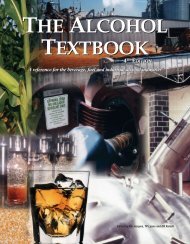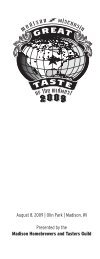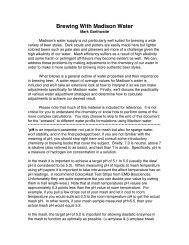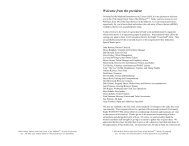The Compleat Distiller
The Compleat Distiller
The Compleat Distiller
You also want an ePaper? Increase the reach of your titles
YUMPU automatically turns print PDFs into web optimized ePapers that Google loves.
THE COMPLEAT DISTILLER 70<br />
A form of extended hot soaking is used in the preparation of Italian walnut liqueur. Green walnuts<br />
(before the shells harden) are packed into large jars and covered with sugar, herbs and grappa at about<br />
80% ethanol. <strong>The</strong> sealed jars are then placed out in the full sun, where they get quite hot every day. In<br />
a few months the contents mature to a delicious, dark liqueur. <strong>The</strong> water in unripe walnuts reduces the<br />
strength of the spirits from around 80% to a final strength of about 40%.<br />
Hot soaking is a technique that's worth trying when cold soaking is ineffective. In general, you should<br />
try the simplest method first – i.e. try cold soaking before applying heat. Experiment with small<br />
quantities before committing yourself to a large batch!<br />
As compounds begin to dissolve in the solvent, they reduce its capacity to dissolve any more of the<br />
compound. Many sparingly soluble compounds require so much solvent to extract them that doing so<br />
is impractical or uneconomical. Franz von Soxhlet was a German chemist who solved this dilemma,<br />
and the device named after him (the Soxhlet extractor) is a mainstay of analytical laboratories to this<br />
day. Like most clever inventions, it is startling in its simplicity, and once you understand how it works,<br />
it is easy to make one of your own.<br />
<strong>The</strong> solvent is boiled in the small container below, and<br />
the vapor travels upward through the bypass tube into<br />
the extraction tube and then into the condenser. <strong>The</strong><br />
hot condensed vapor then drips into the extractor body,<br />
which contains the sample. If the material being<br />
extracted is crumbled or powdered, it is usually held in<br />
a “thimble” made of some porous material, so the<br />
solvent can pass through it.<br />
As pure, hot solvent drips into the extractor body, the<br />
level of liquid rises until all the material is submerged.<br />
<strong>The</strong> compounds we are extracting begin to dissolve in<br />
the pure solvent, and the liquid level continues to rise<br />
until it reaches the top of the “U” tube outside the<br />
main body. When this happens, a siphon is<br />
established, and all the liquid drains back into the<br />
boiling flask.<br />
Fig. 6-2<br />
<strong>The</strong> genius of the soxhlet extractor is that it constantly re-purifies the same small amount of solvent (by<br />
distillation!), and re-uses it. <strong>The</strong> extracted materials are kept in the boiler while the sample in the<br />
extraction chamber is constantly bathed in fresh, pure, hot solvent. This greatly increases the extraction<br />
rate and the concentration of the final product.<br />
Needless to say, volatile compounds do not need the kind of concentrated attack provided by the<br />
soxhlet extractor, but it does an excellent job of rapidly extracting difficult compounds, and is<br />
particularly useful when dealing with small quantities, such as seeds.<br />
Boiling<br />
When neither cold nor warm soaking is fully effective, heating the solvent to its boiling point often<br />
does the trick. This is particularly so when the flavor and aromatic compounds are tightly bound in a<br />
dense matrix of plant material which hinders access by the solvent. Seeds, bark and root material can<br />
all fall into this category and extraction using a boiling solvent is often the only practical way of getting<br />
a good yield. This process is limited to use with products that are not affected by heat, though. Once<br />
again, it makes good sense to experiment with a small quantity before attempting a large-scale<br />
extraction. Many chemical and herbal handbooks contain lists of compounds and botanicals that are<br />
either resistant to, or destroyed by heat.









